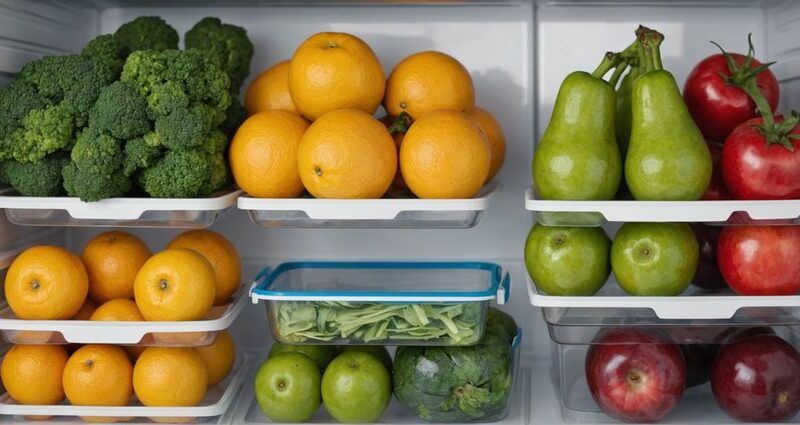Complete Guide on How to Clean Your Refrigerator the Right Way
Cleaning your refrigerator is essential for maintaining a hygienic and fresh environment for your food. A clean fridge not only helps prevent foodborne illnesses but also prolongs the lifespan of your appliance. In this guide, we will explore the complete process of effectively cleaning your refrigerator—from emptying its contents to organizing it neatly afterwards. Follow these steps to ensure your refrigerator is sparkling clean and safe for your family.
Why Cleaning Your Refrigerator is Important

Cleaning your refrigerator is more than just a chore; it’s a crucial maintenance task that can save you from various health risks and costly repairs. A clean fridge prevents the buildup of bacteria, mold, and unpleasant odors, which can contaminate your food. Additionally, regular cleaning can help you keep track of expiration dates, reducing food waste. Here are a few more reasons why you should prioritize this task:
- Enhances food safety by reducing contamination risk.
- Improves energy efficiency and can lower electricity bills.
- Increases the overall lifespan of your refrigerator.
- Provides an organized system, making it easier to find items.
- Helps identify and discard expired or spoiled food items.
Step-by-Step Guide to Clean Your Refrigerator

To clean your refrigerator effectively, follow these steps:
- Empty the Fridge: Start by removing all food items, beverages, and condiments. Check for expiration dates and throw away anything that is spoiled or no longer needed.
- Remove Shelves and Drawers: Take out all removable parts, such as shelves, drawers, and bins. This will allow for a thorough cleaning of every nook and cranny.
- Prepare Cleaning Solution: Fill a bowl with warm water and add a few drops of dish soap. For a natural alternative, use a mixture of equal parts vinegar and water.
- Clean Interior Surfaces: Use a sponge or cloth to wipe down the interior walls and surface areas. Pay close attention to any spills or stubborn stains.
- Wash Shelves and Drawers: While the interior is drying, clean the removed shelves and drawers in the sink using the soapy water solution. Rinse and dry them before placing them back.
- Reorganize and Restock: Once everything is clean and dry, return the shelves and drawers to their original positions. Carefully restock your fridge, placing items in an organized manner.
Tips for Maintaining a Clean Refrigerator
After completing a deep clean, adopting habits to maintain your refrigerator’s cleanliness is crucial. Here are some practical tips:
- Store food in airtight containers to minimize spills and odors.
- Regularly check dates on food items and discard anything expired.
- Perform a mini-clean every month—wiping down spills and crumbs as they occur.
- Keep baking soda inside to absorb unwanted odors.
- Ensure the fridge temperature is set to the appropriate level (typically 37°F or 3°C) to maintain food freshness.
Common Mistakes to Avoid When Cleaning Your Refrigerator
To achieve the best results when cleaning your refrigerator, be aware of these common pitfalls:
- Not unplugging the fridge: Always unplug your refrigerator before starting the cleaning process to ensure safety, especially when cleaning the back or underneath.
- Using harsh chemicals: Avoid bleach or strong cleaners that can leave residues or fumes. Stick to mild soap or natural solutions instead.
- Neglecting the freezer: Don’t forget to clean the freezer compartment if your refrigerator has one. It’s essential to maintain overall hygiene.
- Skipping the door seals: Wipe down the rubber door seals; they can collect grime and impact the efficiency of your fridge.
- Reorganizing without planning: Organize your items according to frequency of use, with everyday essentials within easy reach.
Conclusion
Cleaning your refrigerator is a simple yet crucial task that can significantly enhance your kitchen’s hygiene and efficiency. By following the steps outlined above, you can ensure that your fridge remains a safe and organized space for all your food storage needs. Remember to establish a routine—cleaning your refrigerator regularly helps you keep track of its contents and maintain cleanliness, ultimately contributing to a healthier lifestyle.
FAQ
1. How often should I clean my refrigerator?
It is recommended to clean your refrigerator at least once every three months. Additionally, performing a quick wipe-down of spills and checking for expired items monthly will help maintain cleanliness.
2. Can I use vinegar in my cleaning solution?
Yes, vinegar is an excellent natural cleaner. It effectively removes odors, stains, and bacteria, making it safe for food storage areas.
3. What is the best way to remove sticky residues?
You can use a mixture of baking soda and water to create a paste, applying it to the sticky area and letting it sit for a few minutes before wiping off with a damp cloth.
4. Should I throw away food that has been in the fridge too long?
Yes, always discard food items that show signs of spoilage or have exceeded their expiration dates to prevent foodborne illnesses.
5. How do I keep my refrigerator smelling fresh?
Besides regular cleaning, placing an open box of baking soda inside the fridge can help absorb odors and keep the appliance smelling fresh.
